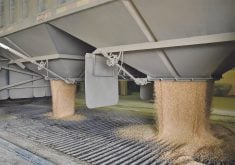Organizations say harmonizing test weight tolerances at the higher export standard is not in producers’ best interests
Two Saskatchewan organizations want the Canadian Grain Commission to reverse its decision to harmonize test weight tolerances at the higher export standard.
Sask Wheat and the Agricultural Producers Association of Saskatchewan issued a press release July 17 saying the decision to eliminate the primary elevator tolerance could be financially detrimental for producers.
Effective Aug. 1, the different standards for test weight and total foreign material in most western Canadian wheat classes are to be the same at primary elevators and for export.
The organizations said this could lead to quality downgrades and lower prices at primary elevators.
Read Also

Manitoba community projects get support from HyLife
HyLife Fun Days 2025 donated $35,000 each to recreation and housing projects in Killarney, Steinach and Neepawa earlier this fall.
Sask Wheat chair Brett Halstead said country elevators have always had the ability to blend deliveries to meet the standards.
“What’s going to happen is you’re going to have one small area of the province, maybe five, 10, 15 percent of the province, that’s going to have low bushel weight some year and within that area they’re not going to be able to blend, yet the company is going to be able to send that grain to export and it will get blended at the port and the grain company will get the entire benefits of that blending,” he said.
The new standard will be 385 grams per half-litre, which the grain commission said is about the same as 60 pounds per bushel.
However, Halstead the commission used the smaller American bushel, known as the Winchester, in that measurement, rather than the Canadian, or Avery, bushel.
According to a chart on the grain commission’s website, the equivalents are 63.3 lb. in the Avery measurement and 59.8 lb. in the smaller bushel.
He agreed that most deliveries likely meet the export test weight but worried that a delivery of 60.1 lb. might be graded as feed. Without blending opportunities, that farmer might lose money.
The organizations also said the commission ignored a motion passed at the most recent Western Standards Committee meeting that asked for a delay in implementing this change until an economic analysis could be completed.
APAS president Ian Boxall said the grain commission is supposed to work for producers’ best interests.
“Saskatchewan farmers are left wondering how these changes could proceed without completing the economic analysis that producers have asked for,” he said.
CGC spokesperson Remi Gosselin said that isn’t something the commission would do.
“It’s not part of our role,” he said, adding that is more within the purview of an organization such as Sask Wheat.
“We have not conducted economic analysis on considering changes to the official grain grading system. We only do scientific research focused on grain quality and its functionality impacts.”
Gosselin said there was significant consultation before the changes, which are part of a larger modernization initiative launched in 2017.
“We’re kind of surprised, to say the least, at the reaction that we’ve got from Sask Wheat,” he said.
The 2022 harvest sample program for wheat found just 14 hard red spring samples out of 3,380 downgraded to feed because of test weight, he said. The majority dropped to No. 2, which is what most companies purchase.
Halstead said Sask Wheat met with the grain commission in June and doesn’t dispute the idea that heavier wheat is better.
“Most wheat is sold at 2 or better, outside of probably Japan, so we’re kind of wondering what is our strategy as a country if we keep setting these standards so high and it gets more difficult to meet them, yet we’re doing it for a limited number of customers because we’re competing on a global market for more of a medium quality.”
He said wheat growers have registered their protest to the changes by raising the concerns, although he would like to see the decision reversed.
Gosselin said that requires regulatory changes that are “virtually impossible” at this point.
















